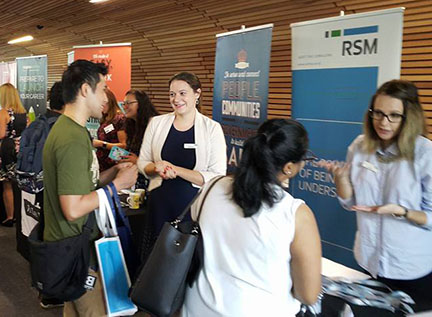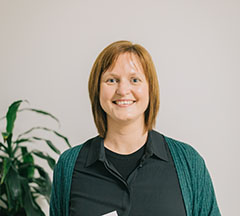Let LinkedIn work for you!

When Emma O’Mahony is looking for potential applicants for new roles as part of her job with specialist recruitment agency Robert Walters, her first port of call is LinkedIn and LinkedIn Recruiter.
“As a professional network, LinkedIn gives me a more indepth detailed story about you, your brand, your passions and the route your career is taking.”
She says LinkedIn also provides valuable insights into a persons’ skill set, who they are connected with, the companies they’ve worked for and projects they’ve been involved in.
With 7,000 connections across Ireland and New Zealand, Emma does about 90% of her headhunting through LinkedIn, followed by Robert Walters database and SEEK.
“I’ve built my own data base through LinkedIn and I also use LinkedIn Recruiter which offers advanced search skills so I can source a diverse range of candidates in different areas,” says Emma, who is a principal technology consultant at Robert Walters.
Read Emma's 5 top tips about using LInkedIn
LinkedIn Recruiter adds even deeper layers says Emma, by enabling her to search using key words associated with roles she is recruiting for, including qualifications and skills.
“Essentially I can access anyone – ONCE their LinkedIn profile is complete. If you do not have a complete profile, you probably won’t come up in a search.”
Tip 1
Get your profile completed if you’re wanting to be seen for job possibilities
If you’re finding it hard to work out what key words to use, let LinkedIn help you do that, says Emma. As you start to fill in your profile, LinkedIn will start to auto populate and throw up suggestions. These will be key words that organisations are looking for so think carefully and choose wording that reflects the roles you’re wanting to enter.
“But also look very closely at job descriptions and make sure that any of the key skills asked for in a job description are in your profile IF you indeed have those skills. The skills you put down must accurately represent your experience – your LinkedIn profile must be 100% truthful.”
And be comprehensive, she adds.
“Don’t leave out things that you think are unimportant but are related to the workplace. It may take just one word that a hiring manager scans, sees and decides they want. Also make sure you’re using the language that your industry use.”
Tip 2
Take note of key skills recruiters are looking for and use their terminology to describe your skills in your profile
Emma also keeps up to date through LinkedIn with the marketplace, observing trends, projects, movement and tenure of people across organisations.
“I recommend students do this too. You can soak up a lot of information from LinkedIn that you can then talk about when you’re at interviews to show you’ve done some research and know a bit about the market,” says Emma.
She also suggests looking up people attending events or interviewing you (if you know who they are) to find out about their background and whether you have anything in common with them.
“I use LinkedIn 24/7. I swear by it. For me it is about staying connected and understanding the market.”
Tip 3
Follow and research organisations, especially before interviews, so you have knowledge of the market and the person interviewing you
The wealth of information sitting on LinkedIn cannot be underestimated, says Emma. She recommends graduates who have a long term goal but are unsure of how to get there (eg software architect or UX designer), to use LinkedIn to find people in those roles and look at how they have navigated their career path to that point.
Tip 4
Unravel people’s career pathways to see the many ways people reach their passions
While it is important to keep building your networks, do it intelligently and respectfully.
 If you bump into someone at a meet up or conference and they suggest you link in with them - don’t over do it, warns Emma.
If you bump into someone at a meet up or conference and they suggest you link in with them - don’t over do it, warns Emma.
“Don’t pester people, yes, link in with them, remind them of how you met, who you are and the roles you’re interested in, but then leave it at that. A one time message is all that is required.”
She says continually messaging someone through LinkedIn is unprofessional and disrespectful of that person’s time.
“However if a position comes up in their organisation or there is a valid message to get in touch again, that is quite different.”
Tip 5
Be careful with your approaches on LinkedIn. Rule of thumb: do a one-off friendly message, then shine in other ways on LinkedIn so contacts stay aware of you
AUT graduate Hilary Esterhuizen, who is now working as a junior business analyst for VKSix, was approached recently on LinkedIn  by a recruiter who was looking for a business analyst. The person invited her to send her CV and best contact number, adding they’d contact her soon.
by a recruiter who was looking for a business analyst. The person invited her to send her CV and best contact number, adding they’d contact her soon.
She wasn’t actively looking for a new role but was curious to see what would happen and promptly replied.
“I was surprised and excited about the fact my LinkedIn profile was ‘working for me’ even though I wasn’t actively looking for a new role.”
Hilary keeps her profile up to date with relevant additions as time goes by. She figures she spent four to six hours on it originally, including discussing aspects of her profile with the Employability and Careers team when she was at university and doing the AUT Edge Award.
CVs/Cover letters
- 7 Tips on creating a great CV
- Personal Statement? Career Objective? What?
- Why bother with LinkedIn?
- Why bother to write a cover letter?
Job search skills
Career advice
- Bringing passion into the mix
- Don't let rejection end your dream
- Employability Skills - how to figure them out!